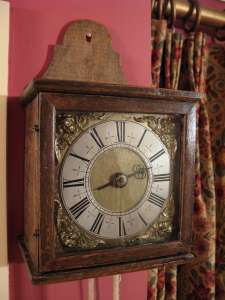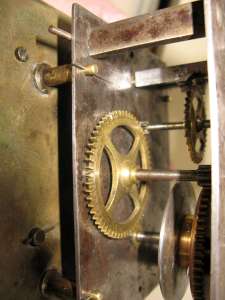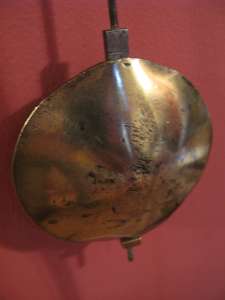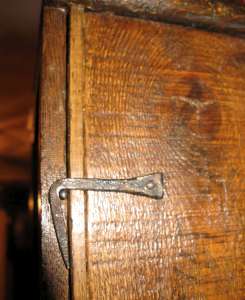
|
This clock represents a copy of a mid 18th century ‘salt box’ hooded wall clock.
These clocks were probably amongst the cheapest clocks available and were either
basic timepieces with alarm, striking timepieces or just plain timepieces, as is
this clock. The word ‘clock’ comes from the Latin word for bell. Thus, if a
machine (timepiece) struck a bell it is a clock, whereas if it just told the
time it is a timepiece. It can get more complicated because although this clock
is strictly a timepiece, as time has gone by timepieces are now known as clocks.
In the 14th century when only monks rang a bell to denote the time of day, it
was much more significant as the combination of a timepiece with a bell gave the
dawning to the name ‘Clock’.
This clock is made from mechanical parts from the late 17th and early 18th century.
The 6” square brass dial with cherub spandrels decorated with engraving between,
5” chapter ring with trident half hour markers and finely matted centre all c1675.
The hand is c2007 and beautifully made by Chris Lowe of ‘Richard's of Burton’.
The movement is made from iron and brass. Hand beaten front and rear plates with
rectangular pillars, iron pinions mounted with nicely shaped brass collects to
brass wheels. The pinions run in brass bushes within the iron front and back plates
to reduce wear. Rope driven with period weight and early pyramid shaped pendulum
all c1740. There is sixty-five years between dial and movement. No, they did not
start life together; they were part of the Gillows Estate. Both were found in a box
of parts and begged to form an alliance.
|

|
Chris Lowe worked on a solution to bring this clock to life in a sympathetic manner.
Chris’s greatest challenge was a clutch assembly for the hand as there was no motion
work. Once designed and made the clock burst into life and runs with a nice, even beat.
The anchor escapement with it's 35” pendulum, swinging somewhat faster than a royal
pendulum clock. The sound is neither like that of a birdcage or a plated movement
emulating country clockwork.
It runs just as a primitive clock of this time would have.
Country clocks often had varied wheel counts which resulted in different pendulum
lengths and running times.
This arrangement is found on many Lantern and Hooded wall clocks. They did not require
the minute swinging royal pendulum of 39”, a requirement for the second hand, to show
the 60 seconds in each minute.
It just adds to the pleasure of owning and working on early weight driven clocks!!
|

|
The case is interesting, in so much as it is of a salt box design. Salt boxes were common items at this time and cheap to make so an ideal adaptation for a inexpensive clock.
The case is made from a pine box c1820, with very little wood to spare.
In conclusion this small hooded wall clock has a running time of around 30 hours, blending well with its surroundings much as it would have some 250 years ago. Although a copy - much like an original.
A super clock.
|

|
Pendulum bob.
|

|
Door hook.
|